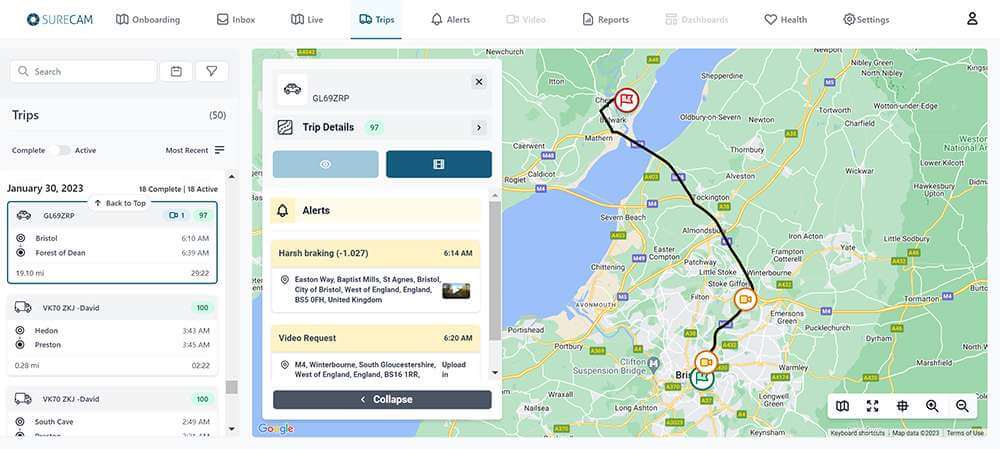Driver Safety Incentive Programs to Improve Fleet Performance
Key considerations when building a driver safety incentive program from the ground upHow One Fleet Drives Safer Habits with Incentives
One of our clients successfully uses SureCam’s driver scorecard to run a quarterly incentive program that rewards safe driving. The top-scoring driver at the end of each quarter earns a bonus, encouraging consistent safety improvements across the fleet.
Thinking about launching your own Safety Incentive Program? Here are six key factors every safety manager should consider before getting started.
Six things every safety manager needs to know about safety incentive programs
Fleets walk a tightrope between driver shortages and increased safety concerns from safety managers and fleet safety directors. Safety incentive programs provide the perfect solution for reducing incidents and rewarding drivers. But how can safety managers gauge how their drivers are performing, and then either coach or reward them appropriately?
One of our clients has had success using SureCam to run a quarterly incentive program based on a simple driver scorecard. The driver with the best score at the end of the quarter is awarded a bonus. What type of Safety Incentive Program would work best for your fleet? Here are 6 things that every safety manager needs to know before rolling out a new Safety Incentive Program.
1. Safety incentive programs are good for drivers
Safety incentive programs, or driver safety programs, give fleet safety directors a way to recognize and reward safe driving. Having a formal safety incentive program tells drivers exactly how they will be evaluated and eliminates the guessing game. It also helps make sure that recognition is fair, and that rewards are distributed evenly based on merit.
2. Rewarding positive driving is just as important as coaching after negative incidents
Driver buy-in is key for any new program to succeed. The problem that many fleets experience when they roll out new safety programs is that drivers feel like they are being put in the hot seat. Without a driver safety incentive program in your fleet, it can be easy to fall into a habit of only acknowledging when things go wrong, instead of recognizing your drivers when they are doing the right things. Recognizing your drivers who do the right things is one way to make a safety program more attractive.
3. Fleet cameras make measuring driver performance easier than ever
SureCam’s network-connected cameras and safety technology make it easy to gauge the performance of your drivers. With SureCam, you receive incident video and driving data in real-time –instantly, from the scene. We work with clients to customize each camera’s configurations to provide visibility into incidents they care about. Using a camera solution can also provide you with analytics and reporting, including speed, tracking and g-force data to inform your driver coaching and safety incentive program.
4. You don’t need a sophisticated driver scorecard system to start an incentive program
The best driver incentive program is the one you can implement. You don’t need a sophisticated driver scorecard to get started. Identify a few key things that you can measure with the tools you already have and start rewarding for those things. As your business grows and you have access to more data, you can add on to the program. Ask about SureCam’s automated Driver Safety Scorecard.
5. Have clear guidelines and program timelines
A safety incentive program won’t do your fleet much good if your drivers don’t know about it. Make sure that you clearly outline what you will be tracking and how each driver will be evaluated. Tell your drivers what incentives they are eligible for and make sure they know how often you will be rewarding them. It’s important to keep your program as transparent as possible; after all, you want your drivers to feel that the program is fair and that it will benefit them.
6. Not all incentives have to be monetary — get creative and combine recognition with rewards
Your rewards need to be valuable enough that they will motivate your drivers. That doesn’t mean that you have to give out large amounts of cash, though. Sometimes rewards with a “trophy value” are actually more motivating than a monetary award. Your drivers work hard at their jobs but most of the time that goes unnoticed. Recognizing them among their peers is a great way to motivate your team and reward excellence. Trophies, plaques, letters of recognition, and special company apparel can also be valued prizes. Think about what things would motivate your drivers and then come up with a combination of monetary awards and other forms of recognition that fit your fleet, and your budget.
How One Fleet Drives Safer Habits with Incentives
One of our clients successfully uses SureCam’s driver scorecard to run a quarterly incentive program that rewards safe driving. The top-scoring driver at the end of each quarter earns a bonus, encouraging consistent safety improvements across the fleet.
Thinking about launching your own Safety Incentive Program? Here are six key factors every safety manager should consider before getting started.
Driver Incentive Program Examples
Points system
One driver incentive program example is to start a points program that allows drivers to accumulate points which they can turn in for valuable prizes such as company apparel, a letter of recognition, a restaurant gift certificate, etc. This gives drivers the incentive to practice safe driving habits and the freedom to choose what reward they want to save up for.Trophies and Plaques.
Some drivers may be more motivated by physical awards such as trophies or plaques. Recognize the safest and most reliable drivers with personalized plaques that they can display at home and show family and friends.Monetary Rewards.
Monetary rewards such as bonuses or paid days off can be huge incentives for drivers to focus on safe driving habits. This is a great way to improve the safety of your fleet but can be costly. Evaluate whether or not a points system or physical awards may be sufficient for your team. If you are able to provide a monetary reward for your driver incentive program, employees will no doubt feel appreciated.How Dash Cams Support Truck Driver Incentive Programs
Dash cams can play a significant role in supporting driver incentive programs in various ways. These programs are designed to encourage safe driving behaviors and responsible practices among drivers. Here's how dash cams can contribute to such programsBehavior Monitoring
Dash cams can record and analyze driver behavior on the road, including speeding, aggressive driving, sudden braking, and more. This data can be used to assess driver performance and identify areas where improvement is needed.Objective Performance Metrics
Dash cams provide objective data that can be used to measure driver performance accurately. This data eliminates subjectivity and biases that might arise from manual observations or self-reported information.Incentive Differentiation
With dash cam data, driver incentive programs can be tailored to individual driver performance. High-performing drivers who exhibit safe behaviors can be rewarded more effectively, while those who need improvement can be offered targeted training and support.Accident Analysis
Dash cams can provide crucial evidence in case of accidents. This can help determine fault accurately and provide insights into how the driver could have avoided the accident. Incentive programs can take accident history and fault into account when offering rewards or bonuses.Training Opportunities
Dash cam footage can be used as a training tool. Instead of punitive measures for poor driving behavior, incentive programs can offer training sessions based on the observed incidents. This approach promotes a learning-oriented environment rather than a punitive one.Real-time Feedback
Some advanced dash cams offer real-time feedback to drivers. They can alert drivers about unsafe behaviors like sudden lane changes or tailgating. This immediate feedback helps drivers correct their actions and adopt safer habits.Long-term Behavior Change
Over time, the use of dash cams and the implementation of incentive programs can lead to long-term behavior change among drivers. The constant awareness of being monitored encourages drivers to maintain safe practices consistently.Risk Reduction
Dash cams and incentive programs collectively help reduce the risk of accidents, insurance claims, and other liabilities. This can result in lower insurance premiums for both drivers and the company, leading to cost savings.Data-Driven Insights
Dash cam data can reveal patterns and trends in driving behavior across the entire fleet. This information can guide the development of targeted training programs, policy adjustments, and safety initiatives.Driver Recognition
Incentive programs can use dash cam data to publicly recognize drivers who consistently demonstrate safe and responsible driving habits. This recognition can boost morale and encourage healthy competition among drivers.
Book a demo today!
SureCam offers GPS vehicle tracking, live video, and real-time alerts for efficient fleet management. Get a Demo


